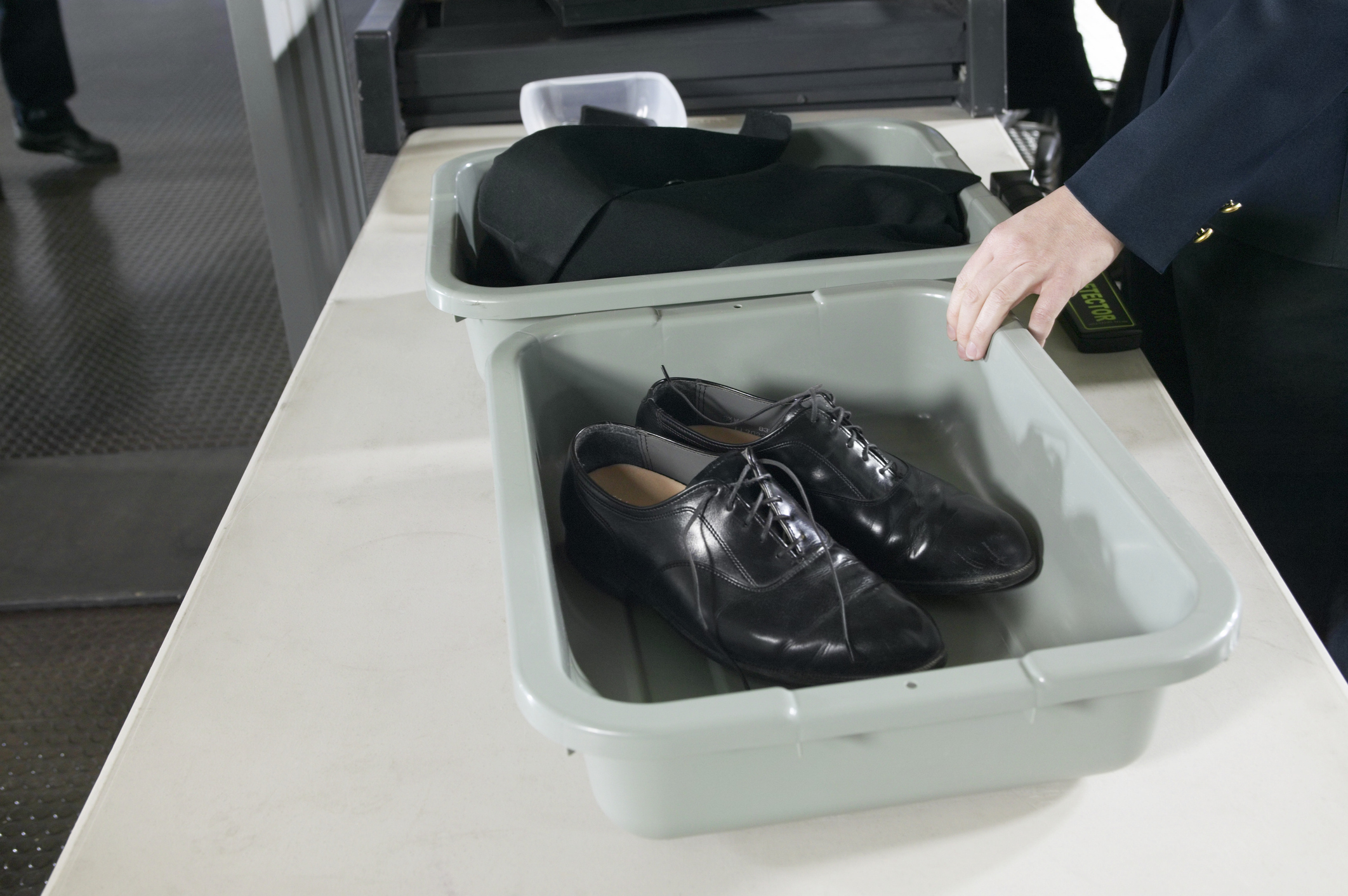The Hated TSA Shoe Removal Rule Was Finally Phased Out
After nearly 20 years, the TSA is ending its shoes-off policy. Travelers will still need a Real ID, and advanced screening remains in place. Here’s what to expect on your next flight.


For nearly two decades, travelers across the country have followed the same routine at airport security: remove your laptop, take off your belt and yes, kick off your shoes. But starting this month, you can leave those shoes right where they belong: on your feet.
The Transportation Security Administration (TSA), under direction from the Department of Homeland Security (DHS), announced that it’s ending its long-standing "shoes-off" policy at airport checkpoints. The change, effective immediately at most major U.S. airports, is part of a broader effort to modernize the passenger screening process and make air travel just a little bit less stressful.
"Ending the 'shoes-off' policy is the latest effort DHS is implementing to modernize and enhance the traveler experience across our nation's airports," said Homeland Security Secretary Kristi Noem in a press release. "We expect this change will drastically decrease passenger wait times at our TSA checkpoints, leading to a more pleasant and efficient passenger experience."
From just $107.88 $24.99 for Kiplinger Personal Finance
Become a smarter, better informed investor. Subscribe from just $107.88 $24.99, plus get up to 4 Special Issues

Sign up for Kiplinger’s Free Newsletters
Profit and prosper with the best of expert advice on investing, taxes, retirement, personal finance and more - straight to your e-mail.
Profit and prosper with the best of expert advice - straight to your e-mail.
Why the shoes-off rule is ending
If you’ve ever wondered why travelers have been required to remove their shoes at airport security, the policy dates back to 2001, when a British man known as the "shoe bomber" attempted to detonate explosives hidden in his footwear during a flight. Since then, shoe removal has become a long-standing and often frustrating part of the airport screening process.
But times, and technology, have changed. Thanks to modern imaging scanners, advanced software and a multi-layered security approach, the TSA says it no longer needs passengers to remove their shoes to ensure safety.
The agency insists that the change will not compromise security and will instead help speed up checkpoint lines, especially during busy travel seasons.
What’s changing (and what’s not) at airport security
While you can now breeze through TSA with your shoes on, other security measures are still firmly in place.
Passengers must continue to:
- Show acceptable identification (REAL ID is now required for domestic flights).
- Go through identity verification and Secure Flight passenger vetting.
- Comply with carry-on screening and liquid rules.
TSA PreCheck members will still enjoy their usual expedited benefits, and the newer "Serve with Honor, Travel with Ease" program, launched earlier this month, offers perks to military families, including PreCheck discounts and fast-lane access at select airports.
A broader shift in airport screening
This policy shift is part of a bigger push by the Trump administration to redefine the airport experience. It's being introduced alongside initiatives like expanded biometric screening and the rollout of digital ID options at select checkpoints.
In May, the TSA completed its full rollout of REAL ID enforcement at U.S. airports, which has already seen a 94% compliance rate. It’s another sign that modernizing security doesn’t have to mean adding more red tape.
A small change with big relief for travelers
After years of grumbling about the shoes-off rule, many travelers are relieved to see it retired. While the policy change may seem symbolic, it represents a larger pivot toward more streamlined air travel.
And for weary travelers just trying to make it to their gate on time, being able to skip the barefoot shuffle at security is a welcome upgrade.
Related Content
Profit and prosper with the best of Kiplinger's advice on investing, taxes, retirement, personal finance and much more. Delivered daily. Enter your email in the box and click Sign Me Up.

Choncé is a personal finance freelance writer who enjoys writing about eCommerce, savings, banking, credit cards, and insurance. Having a background in journalism, she decided to dive deep into the world of content writing in 2013 after noticing many publications transitioning to digital formats. She has more than 10 years of experience writing content and graduated from Northern Illinois University.
-
 December Fed Meeting: Live Updates and Commentary
December Fed Meeting: Live Updates and CommentaryThe December Fed meeting is one of the last key economic events of 2025, with Wall Street closely watching what Chair Powell & Co. will do about interest rates.
-
 This Is Why Investors Shouldn't Romanticize Bitcoin
This Is Why Investors Shouldn't Romanticize BitcoinInvestors should treat bitcoin as the high-risk asset it is. A look at the data indicates a small portfolio allocation for most investors would be the safest.
-
 I'm a Federal Benefits Pro: I Answer These 2 Questions a Lot
I'm a Federal Benefits Pro: I Answer These 2 Questions a LotMany federal employees ask about rolling a TSP into an IRA and parsing options for survivor benefits, both especially critical topics.
-
 Smart Money Moves Savers Should Make in 2026
Smart Money Moves Savers Should Make in 2026These steps will get you on the road to achieving your 2026 savings goals.
-
 How Much Would a $50,000 HELOC Cost Per Month?
How Much Would a $50,000 HELOC Cost Per Month?Thinking about tapping your home’s equity? Here’s what a $50,000 HELOC might cost you each month based on current rates.
-
 My First $1 Million: Self-Employed Trader, 50, San Francisco
My First $1 Million: Self-Employed Trader, 50, San FranciscoEver wonder how someone who's made a million dollars or more did it? Kiplinger's My First $1 Million series uncovers the answers.
-
 Waiting for Retirement to Give to Charity? Here Are 3 Reasons to Do It Now, From a Financial Planner
Waiting for Retirement to Give to Charity? Here Are 3 Reasons to Do It Now, From a Financial PlannerYou could wait until retirement, but making charitable giving part of your financial plan now could be far more beneficial for you and the causes you support.
-
 Are You Ghosting Your Finances? What to Do About Your Money Stress
Are You Ghosting Your Finances? What to Do About Your Money StressAvoidance can make things worse. You can change your habits by starting small, talking with a family member or friend and being consistent and persistent.
-
 Your End of Year Insurance Coverage Review Checklist
Your End of Year Insurance Coverage Review ChecklistStop paying for insurance you don't need and close coverage gaps you didn't know about with this year-end insurance review.
-
 4 Smart Ways Retirees Can Give More to Charity, From a Financial Adviser
4 Smart Ways Retirees Can Give More to Charity, From a Financial AdviserFor retirees, tax efficiency and charitable giving should go hand in hand. After all, why not maximize your gifts and minimize the amount that goes to the IRS?
-
 I'm an Insurance Pro: If You Do One Boring Task Before the End of the Year, Make It This One (It Could Save You Thousands)
I'm an Insurance Pro: If You Do One Boring Task Before the End of the Year, Make It This One (It Could Save You Thousands)Who wants to check insurance policies when there's fun to be had? Still, making sure everything is up to date (coverage and deductibles) can save you a ton.